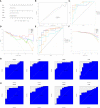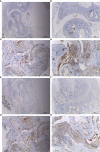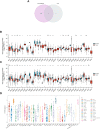Analysis and Experimental Validation of Rheumatoid Arthritis Innate Immunity Gene CYFIP2 and Pan-Cancer
- PMID: 35898498
- PMCID: PMC9311328
- DOI: 10.3389/fimmu.2022.954848
Analysis and Experimental Validation of Rheumatoid Arthritis Innate Immunity Gene CYFIP2 and Pan-Cancer
Abstract
Rheumatoid arthritis (RA) is a chronic, heterogeneous autoimmune disease. Its high disability rate has a serious impact on society and individuals, but there is still a lack of effective and reliable diagnostic markers and therapeutic targets for RA. In this study, we integrated RA patient information from three GEO databases for differential gene expression analysis. Additionally, we also obtained pan-cancer-related genes from the TCGA and GTEx databases. For RA-related differential genes, we performed functional enrichment analysis and constructed a weighted gene co-expression network (WGCNA). Then, we obtained 490 key genes by intersecting the significant module genes selected by WGCNA and the differential genes. After using the RanddomForest, SVM-REF, and LASSO three algorithms to analyze these key genes and take the intersection, based on the four core genes (BTN3A2, CYFIP2, ST8SIA1, and TYMS) that we found, we constructed an RA diagnosis. The nomogram model showed good reliability and validity after evaluation, and the ROC curves of the four genes showed that these four genes played an important role in the pathogenesis of RA. After further gene correlation analysis, immune infiltration analysis, and mouse gene expression validation, we finally selected CYFIP2 as the cut-in gene for pan-cancer analysis. The results of the pan-cancer analysis showed that CYFIP2 was closely related to the prognosis of patients with various tumors, the degree of immune cell infiltration, as well as TMB, MSI, and other indicators, suggesting that this gene may be a potential intervention target for human diseases including RA and tumors.
Keywords: CIA mouse; CYFIP2; GEO; ST8SIA1; WGCNA; pan-cancer; rheumatoid arthritis.
Copyright © 2022 Zhao, He, Yu, Lai, Tang, El Akkawi, Wang, Yan, Huang, Zeng and Zha.
Conflict of interest statement
The authors declare that the research was conducted in the absence of any commercial or financial relationships that could be construed as a potential conflict of interest. The reviewer Z–WG declared a shared parent affiliation with the author MEA to the handling editor at the time of the review.
Figures












Similar articles
-
Identification of diagnostic biomarkers and immuno-infiltration analysis for rheumatoid arthritis based on biological information and WGCNA.Eur Rev Med Pharmacol Sci. 2023 Aug;27(16):7470-7484. doi: 10.26355/eurrev_202308_33398. Eur Rev Med Pharmacol Sci. 2023. PMID: 37667923
-
Predictors of response of rituximab in rheumatoid arthritis by weighted gene co-expression network analysis.Clin Rheumatol. 2023 Feb;42(2):529-538. doi: 10.1007/s10067-022-06438-y. Epub 2022 Nov 14. Clin Rheumatol. 2023. PMID: 36374432
-
Identification of Critical Biomarkers and Immune Infiltration in Rheumatoid Arthritis Based on WGCNA and LASSO Algorithm.Front Immunol. 2022 Jun 29;13:925695. doi: 10.3389/fimmu.2022.925695. eCollection 2022. Front Immunol. 2022. PMID: 35844557 Free PMC article.
-
[Study advances in regulation effect of Tripterygium wilfordii and its extracts on innate immune system in rheumatoid arthritis cases].Zhongguo Zhong Yao Za Zhi. 2019 Aug;44(16):3384-3390. doi: 10.19540/j.cnki.cjcmm.20190103.001. Zhongguo Zhong Yao Za Zhi. 2019. PMID: 31602899 Review. Chinese.
-
Recent advances in CYFIP2-associated neurodevelopmental disorders: From human genetics to molecular mechanisms and mouse models.Brain Dev. 2025 Feb;47(1):104302. doi: 10.1016/j.braindev.2024.104302. Epub 2024 Nov 26. Brain Dev. 2025. PMID: 39603202 Review.
Cited by
-
Identification and validation of biomarkers in membranous nephropathy and pan-cancer analysis.Front Immunol. 2024 May 23;15:1302909. doi: 10.3389/fimmu.2024.1302909. eCollection 2024. Front Immunol. 2024. PMID: 38846934 Free PMC article.
-
Elucidating the role of CYFIP2 in conferring cisplatin resistance in esophageal squamous cell carcinoma.Sci Rep. 2024 Nov 7;14(1):27130. doi: 10.1038/s41598-024-77420-8. Sci Rep. 2024. PMID: 39511293 Free PMC article.
-
Identification of Immune-Related Genes as Potential Biomarkers in Early Septic Shock.Int Arch Allergy Immunol. 2025;186(3):264-279. doi: 10.1159/000540949. Epub 2024 Sep 30. Int Arch Allergy Immunol. 2025. PMID: 39348809 Free PMC article.
-
Study of molecular patterns associated with ferroptosis in Parkinson's disease and its immune signature.PLoS One. 2023 Dec 21;18(12):e0295699. doi: 10.1371/journal.pone.0295699. eCollection 2023. PLoS One. 2023. PMID: 38127902 Free PMC article.
-
Identification and validation of potential hypoxia-related genes associated with coronary artery disease.Front Physiol. 2023 Aug 10;14:1181510. doi: 10.3389/fphys.2023.1181510. eCollection 2023. Front Physiol. 2023. PMID: 37637145 Free PMC article.
References
Publication types
MeSH terms
Substances
LinkOut - more resources
Full Text Sources
Medical

